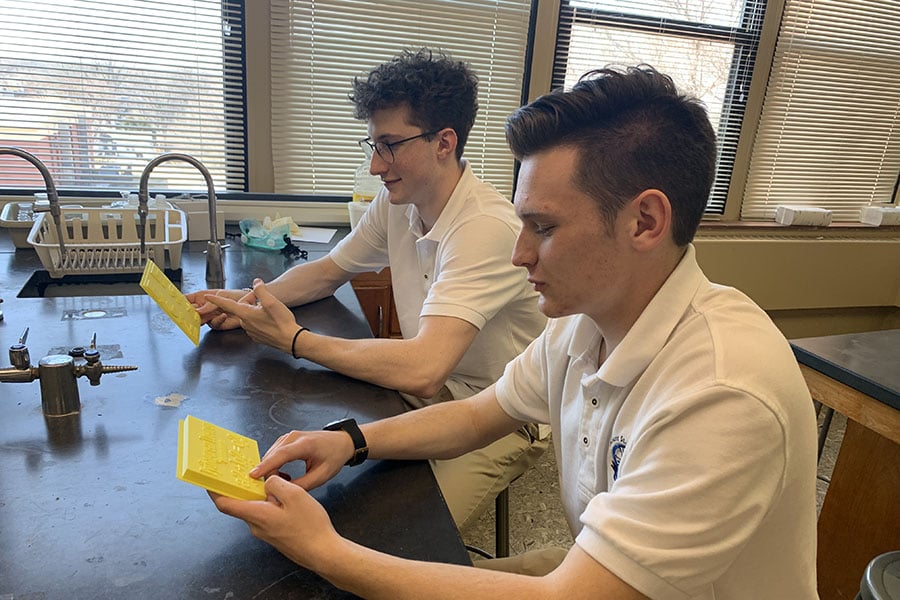![Mount St. Mary Catholic High School students Adam and Devin with their projects [Image via Lumi Industries]](https://fabbaloo.com/wp-content/uploads/2020/05/Adam2Band2BDevin3_img_5eb09c3cba2c0.jpg)
Lumi Industries’ Text to Braille Converter is a heartening use of open source software.
Yesterday, 21 February, was National Braille Day in Italy, Lumi’s home country. (The first-ever World Braille Day was celebrated for the first time on 4 January of this year.) Braille, a tactile written language, allows the visually impaired to read through touch. As World Braille Day explains of the language:
“Braille (named after its inventor in 19th century France, Louis Braille) is used by blind and partially sighted people to read the same books and periodicals as those printed in a visual font. Use of braille allows the communication of important information to and from individuals who are blind or partially sighted, ensuring competency, independence and equality.”
Definitely something to celebrate. And, because Braille features raised dots, it’s a great fit for 3D printing. This technology has long been used for projects with Braille and other tactile aids to increase accessibility to art, educational resources, and more for those who see through their hands.
Lumi, which makes a foldable tablet-powered resin 3D printer, is not afraid to play around with tech to make new advances. It’s not all play, though, as the company maintains a Lumi Industries Care program through which the company has, since its inception, “dedicated part of its resources on social projects involving 3D Printing.” Corporate social responsibility (CSR) programs allow companies to use their tech not just for the bottom line, but to make an actual impact on the society in which they function.
So for this year’s National Braille Day, Lumi examined the educational impact of its Text to Braille Converter, its first Care project release. The converter, an open source free software resource, is an easily accessible resource to create 3D printable models incorporating Braille. It translates text into Braille, making an .STL file printable on a resin-based 3D printer that can be used as easily-made and -applied labels.
Oklahoma City teacher Margaret Whitaker used the converter at Mount St. Mary Catholic High School. Her students put 3D printing to use to create assistive aids, entering a design contest to create educational tools for visually impaired students. Such challenges provide incentives for designers to do some good.
“Initially, my students were a little intimidated by the idea of entering a national contest and trying to develop an original item for these students. Once they got over the fear of competing at the national level, they got very engaged and eagerly began coming up with ideas,” Whitaker explained.
The students, enrolled in Whitaker’s half-year introduction to CAD for 3D printing course, used TinkerCAD and the Text to Braille Converter to create projects including teaching tools for the alphabet, shapes, Pythagorean theorem, and more. While they were finished a bit late to submit to the contest, the students’ work represented excellent teaching tools and Whitaker has shared them with her colleagues, including the community of educators at Ultimaker.
Classroom use of 3D printing is helping students of all ages and levels of experience gain access to increasingly important tools. Projects like this help students — and showcase companies’ ability to — help others. Actively engaging with assistive device creation creates compassion while also building up skills in design and creation.
“The field of 3D printing is growing ever more interesting and relevant to society. By introducing the capabilities to our young students, we can set the groundwork for inventions and applications that have never even been imagined at this time,” Whitaker said.
Such initiatives are heartening in highlighting not only the good that technology can do to aid society and celebrate assistive advances, but the importance of CSR initiatives for companies to give back. Whitaker found Lumi’s software through general internet search for classroom tools; because it was open source, free, and accessible, she was able to integrate it right into her lesson plan.
Via Lumi Industries and Lumi Industries Care











If you’re a youngin’ whose neurons have just myelinated or an educator who’s responsible for bludgeoning their brain tissue with knowledge, there’s a 3D printer option you’ll want to add to your lab list – A RIZE 3D Printer.